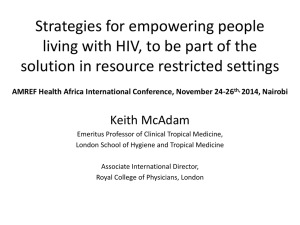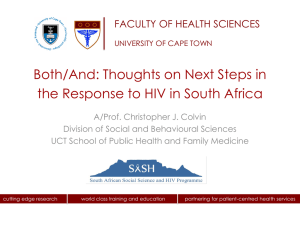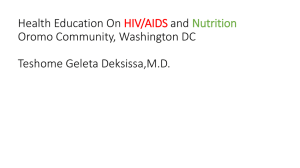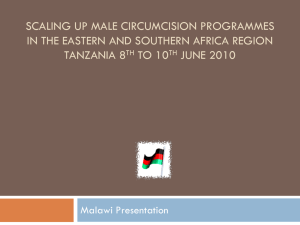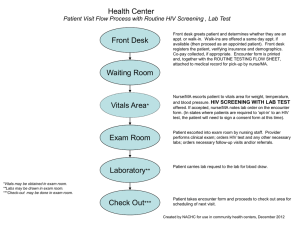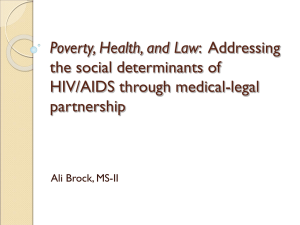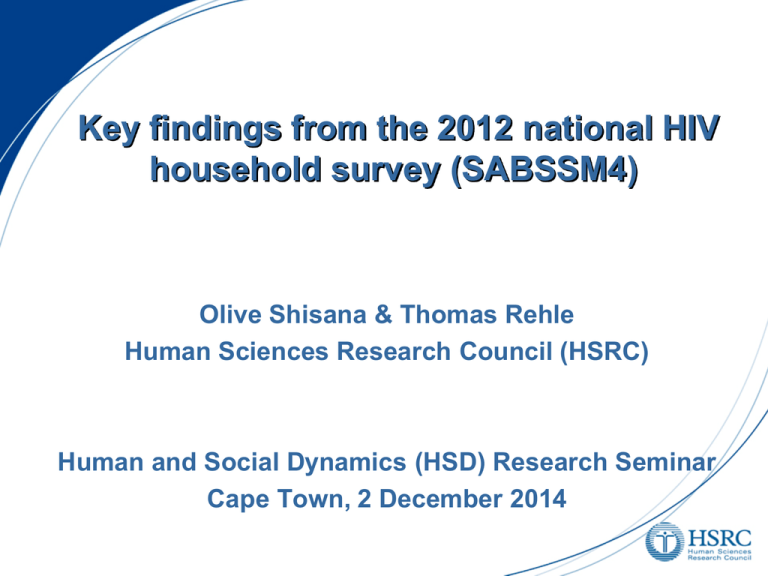
Key findings from the 2012 national HIV
household survey (SABSSM4)
Olive Shisana & Thomas Rehle
Human Sciences Research Council (HSRC)
Human and Social Dynamics (HSD) Research Seminar
Cape Town, 2 December 2014
Background
• This is the fourth national population-based survey, three
similar surveys were conducted by the same team in
2002, 2005 and 2008.
• The study has provided an important gauge of the HIV
epidemic of South Africa.
• The results are used to both inform and evaluate
important health programmes such as the National
Strategic Plan (NSP) on HIV/AIDS, STI and TB, and the
National Health Insurance, among others.
National HIV Household Surveys
South Africa
• Main survey objectives:
- to obtain national, representative data for the entire
population
- to estimate HIV prevalence & HIV incidence
- to measure behavioral / socio-demographic and health
indicators
• Reporting domains:
Age
Sex
Race
Locality type
(urban formal, urban informal, rural formal, rural
informal)
Province
National HIV Household Survey
South Africa 2012
• Survey period: January 2012 – November 2012
38,431 interviewed
28,997 tested for HIV
Laboratory Testing
Dried Blood Spot
HIV Ab screening
PCR (infants)
Ab Pos
HIV Incidence Testing
(> 2 years)
Antiretrovirals
ARVs
HIV PREVALENCE
National HIV Household Survey
South Africa 2012
• HIV prevalence, total population: 12.2%
(2008: 10.6%)
• 6.4 million living with HIV/AIDS
HIV prevalence by age and sex,
South Africa, 2012
HIV prevalence by sex (15-49 years),
South Africa, 2012
HIV prevalence by race group
(15 – 49 years), South Africa 2012
HIV prevalence by locality type
(15 – 49 years), South Africa 2012
HIV prevalence by province
(15-49 years), South Africa, 2012
Trends in HIV prevalence in children,
South Africa 2002-2012
Trends in HIV prevalence by age,
South Africa 2002-2012
HIV prevalence among females,
South Africa 2008 and 2012
40
36.0
32.7
35
31.6
28.0
30
28.4
25
21.1
29.1
24.8
19.7
20
17.4
15
14.8
16.3
14.1
10
5
6.7
2.4
9.7
10.2
5.6
7.7
2.4
1.8
0
0 to 14 15 to 19 20 to 24 25 to 29 30 to 34 35 to 39 40 to 44 45 to 49 50 to 54 55 to 59
60+
ANTIRETROVIRAL TREATMENT
(ART) EXPOSURE
→ need to test for ARVs in HIV surveys!
ART rollout in South Africa
(L. Johnson, SAJHIVMED 2012)
2,000,000
1,800,000
1,600,000
1,400,000
1,200,000
1,000,000
800,000
600,000
400,000
200,000
0
2004
2005
2006
2007
2008
2009
2010
2011
ART Exposure, South Africa mid-2012
Variable
National
Males
Females
Estimated number
of people living
with HIV (n)
Estimated Proportion of people
number on
living with HIV on
ART (n)
ART (%)[95%CI]
6,422,000 2,002,000
31.2 [28.1-34.5]
2,531,000
651,000
25.7 [21.2-30.8]
3,873,000 1,344,000
34.7 [31.4-38.2]
ART Exposure by Age Group, South
Africa mid-2012
Variable
Estimated
number of
people living
with HIV (n)
Estimated
Proportion of
number of
people living with
people on ART HIV on ART (%)
(n)
[95% CI]
Age group
0-14
368,879
166,025
45.1 [33.9-56.9]
15-24
720,269
102,868
14.3 [10.0-20.0]
25-49
4,705,506
1,466,412
31.2 [27.4-35.2]
610,323
260,490
42.7 [35.7-50.0]
15-49
5,425,776
1,569,280
28.9 [25.6-32.5]
Total
6,422,179
2,002,350
31.2 [28.1-34.5]
50 and older
HIV INCIDENCE ESTIMATION
Estimating HIV Incidence
South Africa 2012
1. Direct HIV incidence using blood specimens
- Multi - assay testing algorithm
2. Indirect HIV incidence using mathematical models
- HIV incidence estimation from HIV prevalence data collected in
repeated national population-based surveys
- EPP/Spectrum; Thembisa
Social science that makes a difference
Direct, assay-based HIV incidence
rates by age and sex, South Africa 2012
Age Groups
Age ≥ 2years
Total
Male
Female
Age 15-24 years
Total
Male
Female
Age 15-49 years
Total
Male
Female
Social science that makes a difference
HIV incidence % (95% CI)
1.07 (0.87 – 1.27)
0.71 (0.57 - 0.85)
1.46 (1.18 - 1.84)
1.49 (1.21 – 1.88)
0.55 (0.45 - 0.65)
2.54 (2.04 - 3.04)
1.72 (1.38 – 2.06)
1.21 (0.97 - 1.45)
2.28 (1.84 - 2.74)
Comparison with mathematical models
Method
Period
15-49 incidence %
LAg avidity/
ARV / VL
2012
1.72
Synthetic
cohort
2008-12
1.9
EPP/Spectrum
2011/12
1.52
Thembisa
2011/12
1.47
HIV incidence rates by sociodemographic and behavioral variables
South Africa 2012
Variables
HIV incidence % (95% CI)
Locality type (15 years and older)
Urban formal
Urban informal
1.29 (1.03-1.55)
4.42 (3.42-5.09)
Selected at-risk populations
Sexually active females 15-24 yrs
Black African females 20-34 yrs
3.53 (2.83 - 4.23)
4.54 (3.64 - 5.44)
Number of sexual partners in the past 12 months (15-49 yrs)
One partner
1.67 (1.33 - 2.01)
More than one partner
Social science that makes a difference
2.43 (1.95 - 2.91)
Behavioural Findings
Social science that makes a difference
Awareness of HIV status (%)
Awareness of HIV status among those who
tested in the last 12 months, by sex (15 years
and older), South Africa 2005-2012
60
46.3
50
36.4
40
28.7
30
24.7
19.8
20
10
41.5
13.3
10.2
11.9
0
Males
Females
2005
2008
2012
Total
Condom use at last sex by age and
sex, South Africa 2002-2012
Multiple sexual partnerships
(15-49 years), South Africa 2002-2012
Age-disparate sexual relationships
in the 15-19 years age group
South Africa 2005-2012
Sex before the age of 15 years (%)
Sexual debut before age 15 years
(15-24 years), South Africa 2002-2012
25
20
15
16.7
13.1
11.9
11.3
5.1
5.9
10
5
5.3
5.0
0
2002
2005
Males
Females
2008
Total
2012
Correct knowledge of HIV transmission and
rejection of major misconceptions (%)
Correct HIV knowledge among key
populations, South Africa 2008 and
2012
45
40
35
30
25
30.1
26.9 27.6
36.1
2012 National Average (26.8%)
33.6
31.8
27.2
23.3
22.7
25.3
24.7
17.7
20
15
2008
10
2012
5
0
Black African People living Black African Disabled (15 High-risk Recreational
females 20- together, not males 25-49 years and drinkers (15 drug users
34 years married (15years
older)
years and (15 years and
49 years)
older)
older)
Key populations at higher risk of exposure
Trends of HIV-related stigma in
South Africa, 2005, 2008, 2012
Percentages of respondents aged 15yrs and older who agreed with 4
statements about PLHIV asked in the past 3 surveys
2005
90.7%
92.1%
2008
2012
91.6%
79%
71.1%
72.5%
50.1%
39.9%
30.5%
14.9%
If you knew that a shopkeeper or food
seller had HIV, would you buy food
from them?
Would you be willing to care for a
family member with AIDS?
15.8%
16.6%
Is it a waste of money to train or give a
promotion to someone with HIV/AIDS?
Would you want to keep the HIV
positive status of a family member a
secret?
ARV
prophylaxis
Male
circumcision
Auvert B, PloS Med 2005
Gray R, Lancet 2007
Bailey R, Lancet 2007
Treatment of
STIs
Grosskurth H, Lancet 2000
Microbicides
for women
Female Condoms
Abdool Karim Q, Science 2010
Oral pre-exposure
prophylaxis
HIV
PREVENTION
HIV Counselling
and Testing
Grant R, NEJM 2010 (MSM)
Baeten J , NEJM 2012 (Couples)
Paxton L, NEJM 2012 (Heterosexuals)
Choopanya K, Lancet 2013 (IDU)
Post Exposure
prophylaxis (PEP)
Scheckter M, 2002
Male Condoms
Coates T, Lancet 2000
Sweat M, Lancet 2011
Treatment for
prevention
Cohen M, NEJM, 2011
Donnell D, Lancet 2010
Tanser, Science 2013
Behavioural
Intervention
- Abstinence
- Be Faithful
Note: PMTCT, Screening transfusions, Harm reduction, Universal precautions, etc. have not been included – this is on sexual transmission
Research Collaborators
Funders
This research has been supported mainly by the President’s Emergency
Plan for AIDS Relief (PEPFAR) through CDC under the terms of
Cooperative Agreement Numbers 5U2GPS000570-05 , 3U2GGH0035702 and U2GPS001328.
1918 – 2013
THANK YOU

